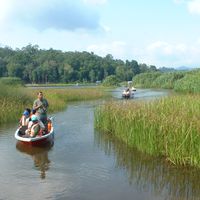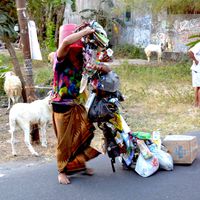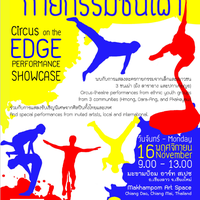Between art and environment: a Thailand Case Study
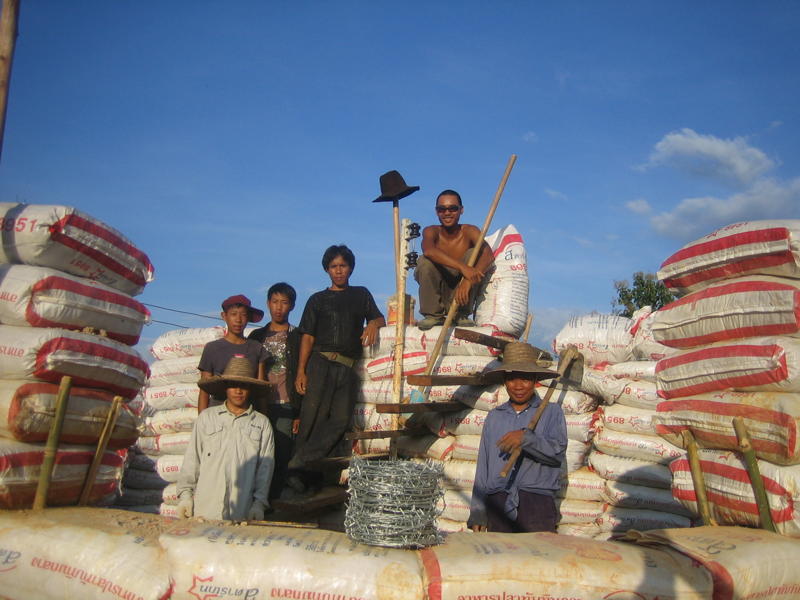 This case study is part of an Asia-Europe Foundation commissioned research project entitled “Linking the Arts to Environment and Sustainable Development Issues”. The concept behind this research was based on the observation that carefully documented case studies can not only provide inspiration for networking and collaboration between Asia and Europe but also aid policy making and planning. The selected researchers investigated initiatives of the culture sector as well as civil society organisations working on environmental issues. The complete list of 20 case studies from a selection of countries in Asia will be available to download online from the beginning of 2012.
This case study is part of an Asia-Europe Foundation commissioned research project entitled “Linking the Arts to Environment and Sustainable Development Issues”. The concept behind this research was based on the observation that carefully documented case studies can not only provide inspiration for networking and collaboration between Asia and Europe but also aid policy making and planning. The selected researchers investigated initiatives of the culture sector as well as civil society organisations working on environmental issues. The complete list of 20 case studies from a selection of countries in Asia will be available to download online from the beginning of 2012.In Doi Saket, an artists’ residency programme brings together local communities and artists to reflect on diverse facets of everyday life to gain a more open perspective about their positions in the contemporary landscape.
[caption id="attachment_17800" align="aligncenter" width="576" caption="Compeung House Building"]
In the Lanna language of the Northern Thais, com means a remark and peung means appropriate. In bringing these two words together, the Northern Thai artist Pisithpong Siraphisut was able to appropriately name the artist residency programme he founded: ComPeung. As Siraphisut elaborated, “Our vision and mission for ComPeung is to create appropriate remarks that are suitable to the situations, environments, and communities we deal with.”
At ComPeung, these remarks take the form of art, whether they be visual, performative, architectural, or new media in nature. This residency programme gathers local and international artists to live and work together on a rural piece of land where they are in dialogue with one another as well as the surrounding community and natural environment. Through such interaction, the residency provides thrilling potential for art inspired by the local context.
ComPeung is located near the village of Doi Saket, which is a short distance from Northern Thailand’s largest city Chiang Mai. Growing up in the area, Siraphisut has seen how the landscape has changed in the face of urbanisation over the years. As more and more young people leave small villages like Doi Saket for opportunities in big cities like Bangkok, the vitality of where they come from has depleted. In response, Siraphisut established ComPeung to revitalise these rural areas that would otherwise remain in the side-lines, relative to the urban attractions of nearby Chiang Mai. On a green plot of land, he created a nesting ground for rich artistic interventions that now provides greater visibility and appreciation for local culture and nature.
In 2005, Siraphisut with Helen Michaelsen as advisor, launched ComPeung’s residency programme, which currently runs throughout the year. The duration of an artist’s stay can span from one to several months with an option to reapply. ComPeung invites local, regional, and international artists who work in a wide range of disciplines to apply to the residency. On varying levels, ComPeung has worked with resident artists to help them secure sponsorship from arts councils, universities, and embassies such as the Japan Foundation, Sapporo Artist-in-Residence (S-AIR), Bangkok Art and Culture Centre (BACC), Chiang Mai University, HOESI University, University of Chicago, the Art Council in England, Government of Western Australia, Conseil des artes et des letters in Quebec, and the Ontario Arts Council in Canada. ComPeung has also worked with the Minimal Gallery in Chiang Mai. Since the initiative began, residents have produced over 30 projects and works-in-progress.
During the residency, artists often find inspiration in local natural resources like bamboo and public spaces such as the village market. At times, they highlight and incorporate such elements in their projects. Some are site-specific and engage community members in the sharing of ideas, stories, and local knowledge. For instance, the American artist and academic Rebecca Zorach enlisted village children in a project that reflected on the existing social order by asking them to re-design their school in an ideal way through drawings and sculptures with the use of natural materials from the environment.
[caption id="attachment_17804" align="aligncenter" width="576" caption="Compeung - Ideal School Project in collaboration with artist Rebecca Zorach"]
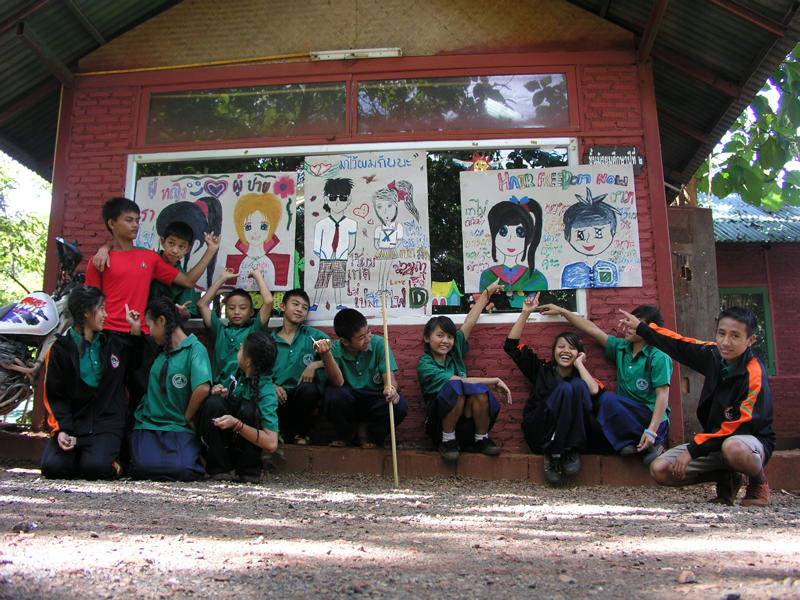 [/caption]
[/caption]In activating public space, the artist Tatsuo Inagaki collaborated with his university students to interview local community members, which then lead to projects and workshops that included a temporary museum. He installed this museum, made in part out of bamboo and grass, in the Doi Saket open market where vendors sell fruits, vegetables, and other wares. The installation served to reflect on local trade and tourism to the delight of curious sellers, students, and children. At the same market, Canadian artist Allison Cummings carried out an edible art exchange which explored intimacy through hospitality when experienced between people coming from different cultural standpoints.
ComPeung also practices and raises awareness about sustainable living. The ComPeung team applies natural building techniques to low-impact accommodations at the residency site. In promoting a minimal lifestyle, only basic necessities are provided at the residency though it is lined with the comfort of warm hospitality. Moreover, residents are fed home-cooked meals made out of locally grown and harvested foods. In response, some artists have reflected on sustainability. For instance, the Japanese resident Tadasu Takamine built an earthen structure and his project has since travelled to Bangkok and Japan to spread awareness about this green building movement.
ComPeung is an excellent model of an artist residency programme that engages artists in activities that spark dynamic dialogue, and revitalise the local environment. The initiative sets artistic practice in a framework of sustainable living. ComPeung carries out environmentally sound actions such as constructing adobe dwellings and buying local, naturally grown produce from the village market. Aligned with the growing earthen building movement in the region, ComPeung has applied different techniques and designs to earthen structures at the site using local materials such as mud, bamboo, wood, grass, rice and coffee husks.
[caption id="attachment_17806" align="aligncenter" width="576" caption="Compeung - Doi Sake Market Exchange"]
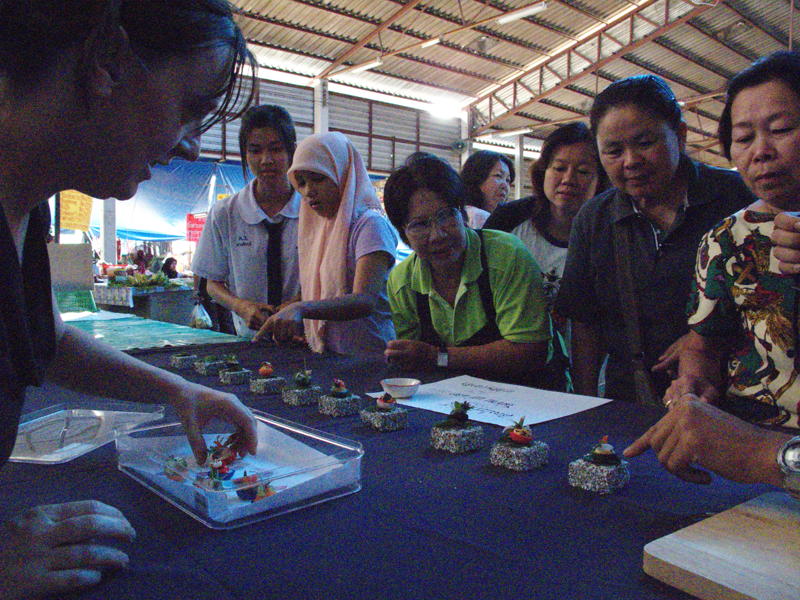 [/caption]
[/caption]ComPeung also provides artists with a form of tourism that is responsible and sensitive to the local area. Siraphisut is seasoned in sharing his expert knowledge of the nearby village of Doi Saket as well as its surrounding hills, forests and natural lakes. He also encourages visiting artists to appreciate and interact with the diverse range of ethnic communities that call this area home. Since ComPeung began, the exchange between resident artists and communities has led to a heightened valorisation of local cultural and natural heritage. In this way, the initiative has improved the way local people view themselves by helping them realize through other people’s eyes how their traditional ways of life contribute to rich and sustainable ways of improving the world. Furthermore, this perspective directly counters the dominant view that urbanisation is the best option for bettering people’s quality of life.
By respectfully working and living together, ComPeung encourages visiting artists and locals alike to acutely reflect on the diverse facets of everyday life in this context and gain a more open perspective about their positions in the contemporary landscape.
In terms of sustaining the initiative, ComPeung requires all residents to pay an artist fee. At times, Siraphisut assists international artists in securing sponsorship from institutions in their respective countries so that they are able to pay this fee. In 2010, ComPeung directly secured a private donation for the first time, which allowed the initiative to provide a one-month residency to two artists for free. In the future, Compeung hopes to secure more resources from public and private sources in order to provide free residencies to local and regional artists who would otherwise not be able to afford the artist fee. Such increased support would also be valuable to building a multi-purpose adobe centre for the use of meetings, workshops, seminars, performances, exhibitions, and screenings.
All the images in this article are courtesy of the ComPeung initiative, Thailand.
Researcher: Karen Demavivas
Karen Demavivas has held positions at various cultural institutions such as the Solomon R. Guggenheim Museum and currently works at the New York Foundation for the Arts. She is inspired by creative projects in Southeast Asia that engage issues of sustainability and the environment and explored it during her time working with local communities in Thailand.
Similar content
22 May 2017
21 Feb 2012
deadline
06 Apr 2010
from - to
16 Nov 2015 - 16 Nov 2015


